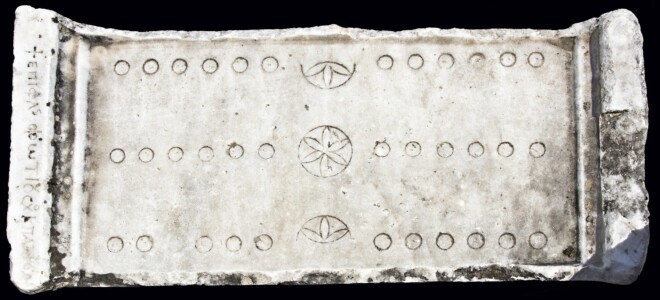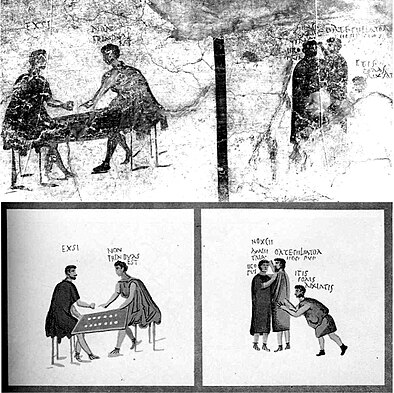
There has long been a recognition of the legacy of Roman civilisation in the contemporary world. Mostly this focuses upon language, religion, jurisprudence and architecture. There is one other legacy that the Roman world bequeathed us that is often overlooked: gambling. The Romans were avid gamblers. They loved games. Roman remains are full of gambling tables, frescoes show Roman gambling, and it seems clear they spent much of their time engaged in these pursuits.
What Games did the Romans Play?
The popular games in Ancient Rome include ones that we’d likely be able to play today, with precursors to noughts and crosses or tic-tac-toe, and games similar to backgammon and chess. In particular, the Romans loved dice, and this game is commonly depicted in images from military sites.
Other games would be less familiar to us. Ludus duodecim scriptorium, which means ‘the game of twelve markings’ is only known through the boards themselves.

These show different columns in groups of twelve. It could be a descendent of the Egyptian game senet, although there is a considerable chronological gap between games. Gameplay appears to have taken place with three cubic dice, and 15 pieces, but how it was actually played is unclear. However, it has been suggested that this was a dice game similar to backgammon.
Ludus Latruncolorum is another board game, which seems to have been based on different military tactics. This seems to have come from an earlier Greek board game called Petteia. There is a brief description of gameplay in the sources: the board represents the city, each piece is moved and you take the pieces of the opponent by enclosing it between two of your pieces. It is mentioned in various sources as a highly respected game of strategy and was used to develop military strategy.
Gaming in Ancient Rome
Gambling is clearly popular in the evidence; gaming tables are particularly common near military camps and sites. There is not so much evidence of gambling taking place in the private home, suggesting that it was commonly considered to be a social activity. Various inscriptions that can be found on tables suggest that foul play was sometimes a problem. A painting in Pompeii shows a brawl taking place between two players. This is interrupted by the landlord of the establish who argues that they should exit.

Gambling with dice is shown to be popular by an enormous prevalence of dice in Roman finds; this had the advantage that the game could be played without the need of a table, and so could be transported and played at a whim. The dice themselves were originally the ankle bones of a sheep or a goat, which were six-sided and relatively level but most dice were clearly asymmetrical. This meant that sometimes the dice were not true, but this did not matter because the outcome of the dice was considered to be a reflection of fate rather than probability so it may have been considered that having perfectly level dice was not a major concern.
In Britain, the most common form of dice used in Roman times had six sides in cubes, as we would recognise them today. Other kinds of dice only had four numbers marked with 1, 2, 3 and 6. The game would proceed by players throwing four dice at a time. If they landed with four different numbers showing, it was a Venus; if it all landed on ‘1’, it was the known as the ‘four vultures.’
Gambling often took place in popina, or wine bar, which also provided a set of simple foods. These were often seen to be the haunts of the lower classes and slaves, and were often a place where prostitution would be offered. As such these wine bars were often portrayed as places of violence and depravity, but it should be remembered that most of these depictions may reflect the snobby attitudes of the upper classes who tended to look down on these places.
Sports Betting in Ancient Rome

It was perhaps the focus on sports betting where gambling was most active. Sports betting was exempt from gambling laws and was decriminalised even in the Christian era. This may have been because it was more likely to take place with small stakes and between friends. Some laws only allowed gambling during contests where the players showed significant strength, such as wrestling, boxing or running. However, in practice it was likely that the Romans bet on nearly any contest that took place.
It was likely that chariot racing, horse racing and gladiatorial contests were big draws for the games, and festivals such as the Saturnalia were great opportunities for gambling. You could even buy tablets which would bring misfortune upon your opponent to increase your chances. In some cases, those wishing to gain the favour of an Emperor would seek to attract his attention by placing large bets on a chariot team that was favoured by the Emperor.
Attitudes Towards Gambling In Ancient Rome
Gambling appears to have been enormously popular in Ancient Rome, so it isn’t surprising that there were periodic attempts to reduce the practice. It was considered possible that someone could lose himself under the euphoria associated with winning, leading to a loss of honour. In 204 BC, the first law regulating gambling was introduced – the Lex Alearia, which forbade gambling with dice. It is argued that this resulted from the economic hardship that took place as a result of the Punic Wars. It might also have been the case that since the state did not collect money from gambling activities, that it was less likely to be sympathetic to these games for much of its history. Such laws were usually suspended during public festivals, which became hotbeds of gambling activity.
However, some of these laws made gambling more of a problem; the fact that gambling was illegal meant that it was not possible to recover debts from this activity, meaning that violence was often used instead. There was paranoia throughout most of Roman history that young men would lose most of their youth to gambling, although at the same time some Emperors such as Augustus and Claudius were keen gamblers themselves and various emperors offered money to their guests to ensure that they kept playing.
As such, there is evidence that much of these games were illegal in Rome, but the archaeological evidence shows they still prevailed. However, sports betting was still allowed and regulated as it was considered to enhance the competition which showed excellence. Juvenal writes of how success in gambling is an attractive quality in a man, impressing his fellows with his betting skill. However, it was not until the sixth Century AD that the emperor Justinian created ways in which gambling could be more easily regulated, allowing for losses to be legally recovered and for houses to be confiscated.
The Roman Legacy of Gambling
Today, the games may have changed, but the tradition remains. Chariot racing may have been superseded by horse racing, and gladiatorial contests are less common compared with football games, but the thrill of the competition remains the same. Dice may not be the most popular game anymore, but betting on chance through slots remains popular. There’s nothing new about having a flutter on the horses or having a go with blackjack, and the Roman contribution to our culture can be summed up in the most famous Latin quote: alea jacta est, or ‘let the dice fly high’, where Julius Caesar uses a gambling metaphor to illustrate the uncertainty of his next move.
So next time you find yourself sitting down for blackjack or having a punt at roulette, you’re participating in an activity shared by Romans from the lowly soldiers stuck guarding Hadrian’s Wall in raining Northern Britain to the similar games practised by the Emperors of Rome at their peak. There’s nothing new about gambling, and we’re all part of a rich and varied human tradition.












